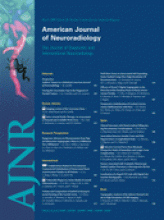In this issue of the AJNR American Journal of Neuroradiology, Habermann et al1 assess the value of diffusion-weighted echo-planar MR imaging in differentiating various types of primary parotid gland tumors in a large group of patients with a lesion of the parotid gland. They claim that, to a certain extent, diffusion-weighted echo-planar MR imaging has the potential for differentiation between various primary tumors of the parotid gland.
Parotid gland tumors are relatively rare and include a large variety of histologic types. Therefore, imaging of those tumors is a major challenge for radiologists.
The management of tumors of the parotid gland requires a detailed understanding of the anatomy and the pathologic processes affecting these glands and surrounding structures. Patients with these diseases are usually referred to a specialist from a head and neck center, where multidisciplinary management is possible. Management by the clinician, usually a surgical specialist for head and neck diseases, is based on history, physical examination, and, always, imaging modalities (most notably, MR imaging) and other investigations if indicated, such as sonography-guided fine-needle aspiration cytology (USgFNAC). In general, FNAC by experienced clinicians or radiologists (under sonography guidance) is able to give certain diagnoses with high, albeit not 100%, accuracy.
The most important division between diagnosis groups lies between benign and malignant (roughly 20%) lesions. Treatment is usually by surgical excision, but the extent is dictated by the pathologic process. The preoperative information on whether a parotid gland tumor is benign or malignant may be helpful to prevent treatment delay in the case of a malignant tumor and in patient counseling as to likely treatment and possible sequels. Also, there are well-established indications for performing an elective neck dissection in the case of high-grade malignant tumors.
All aforementioned methods can help to establish a working diagnosis, but ultimately often only histopathologic assessment after removal of the lesion yields a definite diagnosis on which additional management, if indicated, may be based. Also, within the benign category a distinction between the 2 most frequent tumors (ie, pleomorphic adenoma and Warthin tumor) is valuable because a Warthin tumor, especially in elderly patients or those reluctant to submit to surgery, can be observed with repeated clinical or radiologic measurements.
Therefore, every effort to close the uncertainty gap is highly valuable in patient management, though everyday practice often makes extensive work-up impractical and unnecessary. This is because in many patients, removal is indicated or patients elect to have surgery. Also, if waiting lists for surgery do not dictate otherwise, this is often the most practical and rapid solution. On the other hand, if waiting lists are long, less uncertainty about the diagnosis is extremely helpful to expedite surgery in those in whom high suspicion of a malignant tumor is present.
In contrast to FNAC, a noninvasive examination such as MR imaging might not only be helpful in providing a diagnosis but also with regard to staging by providing information on the exact localization and extent of the lesion. Differentiation between benign and malignant disease is often possible on the basis of morphologic appearance alone.2 However, even the combined accuracy of the modalities USgFNAC and conventional MR imaging may still be imperfect.
New MR imaging modalities such as proton MR spectroscopy,3 dynamic contrast-enhanced MR imaging,4 and diffusion-weighted MR imaging5 have all shown promising results in the differentiation between benign and malignant salivary disease. Regarding diffusion-MR imaging, one should cope with some major challenges. First, diffusion-weighted MR imaging should be, in principle, independent from the MR imaging machine that is used, but it is not entirely certain if this is really true. Hein et al6 applied some type of standardization of apparent diffusion coefficient (ADC) values by comparing it with ADC values of healthy tissues. This may be difficult to realize in the head and neck region because it may be difficult to find reliable tissue for reference. Second, there is some specificity of ADC values for certain tumor types, but these reports are not unequivocal. Therefore, more studies with large patient groups need to be performed. It is reported that the choice of b-value might be helpful in the differentiation of benign and malignant tumors.7 The lower the applied b-values, the higher the influence of perfusion, whereas applying only the ADC by high b-values reflects mainly diffusion.
The value of Habermann's study is that it is the first to report on patients with parotid tumors examined with diffusion-weighted MR imaging. The main limitation of this study was that the number of cases was not satisfactory for every different tumor. Furthermore, the number of malignant tumors as a whole was very limited.
The differentiation of benign and malignant masses may be improved by combining morphologic features and newer MR imaging techniques, such as diffusion-weighted MR imaging, MR spectroscopy, and dynamic contrast-enhanced MR imaging. Additional multicenter research with larger numbers of cases with an adequate distribution among tumor types with use of these novel MR methods is warranted.
References
- Copyright © American Society of Neuroradiology












